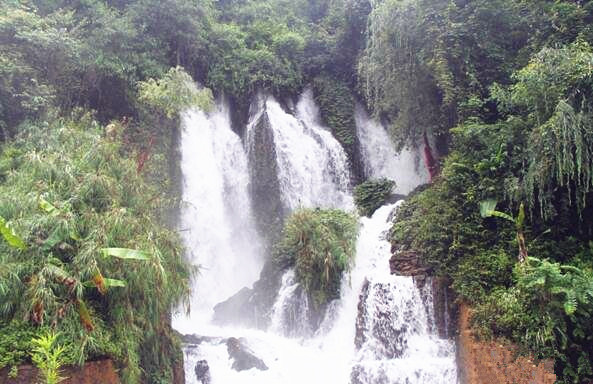
Laowo River in Nujiang
Chinese Name: 怒江老窝河
English Name: Laowo River in Nujiang
Lao Wo River
Lao Wo River is the largest first-level tributary on the left bank of the Nujiang River within Lushui City. Located in the Nujiang Gorge area of western Yunnan Province, it is situated in the northeastern part of Lao Wo Town. The river originates from Jiazong Mountain in Po Jiao Village, Caogang Town, Yunlong County, Dali Prefecture, and is formed by numerous tributaries. Lao Wo River has about 34 major and minor tributaries. The upper reaches are known as Fen Shui Ling River, while the lower reaches are referred to as Lao Wo River. Flowing from east to west, it passes through eight village committees, including Ronghua, Lao Wo, Zhongyuan, Yinpo in Lao Wo Town, and Duanjiazhai, Baishuihe, Xinzai, and Liuku in Liuku Street, before merging into the Nujiang River. The river’s source elevation is 3,168 meters, with a basin area of 579 square kilometers and a river length of 44.6 kilometers. In Lushui City, Lao Wo River is 36.79 kilometers long, with a basin area of 456.7 square kilometers. The elevation at the entry point is 2,187 meters, and the elevation at the river mouth is about 800 meters, with a total drop of 1,378 meters and an average slope of 37.46‰. The designated scenic segment for this beautiful river and lake application extends from the river’s source to Yinpo Village. The banks of this section of Lao Wo River are well-vegetated, with evergreen mountains and a beautiful environment. Since the implementation of the River Chief System, the Lao Wo River has established a three-tier river chief system at the city, town (street), and village levels. Each level of river chief fulfills their responsibilities, overseeing the river’s management and restoration, including riverbank greening projects. New flood control embankments of 4.27 kilometers have been built to effectively protect the safety of the local people and farmland.
Lion and Elephant Bridge on Lao Wo River
Located about 30 kilometers east of Liuku, the Lion and Elephant Bridge is situated near the entrance of the village road in Chongren Village, Lao Wo Town. The bridge features pavilions on both the east and west sides, decorated with intricate carvings of dragons, lions, elephants, and sacred deer. Built by skilled craftsmen from Jianchuan, Eryuan, and Dali, it is also known as “Chongren Flower Bridge” or “Lao Wo Flower Bridge.”
Historically, Lao Wo Town was governed by the Duan Clan of Yunlong. During the Ming Dynasty’s Wanli period, the Duan Clan began constructing an ancient road from the Lancang River’s Feilong Bridge to Pienma Old Road, which crossed various mountains and rivers, including Lao Wo, and extended to the border with Myanmar. This trade route facilitated the exchange of goods such as tea, dairy products, and salt.
The Lion and Elephant Bridge, completed in the second year of the Jiaqing era (1797), was part of the Southern Silk Road’s Bounan (now Yongping) ancient road and an important transportation bridge for the Liuku area. The bridge’s piers are made of stone, with a brick and wood structure and a tile roof. It has been rebuilt five times, with the most recent reconstruction in 1987, where it was reinforced with reinforced concrete and decorated with carvings while maintaining its original architectural style.
The Nujiang River area is known for its diverse bridges, including suspension bridges, stone arch bridges, and others, earning it the nickname “Bridge Museum.” Despite its historical significance, the Lion and Elephant Bridge remains a testament to the perseverance and spirit of the people who built it, continuing to inspire future generations.
Lao Wo River No. 4 Hydropower Station
The Lao Wo River No. 4 Hydropower Station is located in Lushui City, Nujiang Prefecture, Yunnan Province, with an installed capacity of 25,000 kilowatts and operates as a diversion-type hydropower project. In July 2023, it was included in the list of proposed green small hydropower demonstration stations by the Yunnan Provincial Water Resources Department.
The No. 4 Hydropower Station, situated in Baishuihe Village within Lushui County, is the tenth stage of the Lao Wo River’s eleven-stage hydropower development plan. The station plays a significant role in harnessing the river’s water resources and promoting economic development in the border region. It features a single-purpose power generation design and is classified as a Class I small hydropower station. The facility includes an intake hub, diversion system, and plant hub, with an installed capacity of 25 MW (2×12.5 MW) and an average annual power generation of 123.5 million kWh.

 7 Days GolfingTour
7 Days GolfingTour
 8 Days Group Tour
8 Days Group Tour
 8 Days Yunnan Tour
8 Days Yunnan Tour
 7 Days Shangri La Hiking
7 Days Shangri La Hiking
 11 Days Yunnan Tour
11 Days Yunnan Tour
 6 Days Yuanyang Terraces
6 Days Yuanyang Terraces
 11 Days Yunnan Tour
11 Days Yunnan Tour
 8 Days South Yunnan
8 Days South Yunnan
 7 Days Tea Tour
7 Days Tea Tour
 8 Days Muslim Tour
8 Days Muslim Tour
 12 Days Self-Driving
12 Days Self-Driving
 4 Days Haba Climbing
4 Days Haba Climbing
 Tiger Leaping Gorge
Tiger Leaping Gorge
 Stone Forest
Stone Forest
 Yunnan-Tibet
Yunnan-Tibet
 Hani Rice Terraces
Hani Rice Terraces
 Kunming
Kunming
 Lijiang
Lijiang
 Shangri-la
Shangri-la
 Dali
Dali
 XishuangBanna
XishuangBanna
 Honghe
Honghe
 Kunming
Kunming
 Lijiang
Lijiang
 Shangri-la
Shangri-la
 Yuanyang Rice Terraces
Yuanyang Rice Terraces
 Nujiang
Nujiang
 XishuangBanna
XishuangBanna
 Spring City Golf
Spring City Golf
 Snow Mountain Golf
Snow Mountain Golf
 Stone Mountain Golf
Stone Mountain Golf















